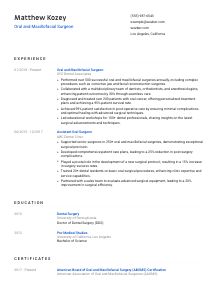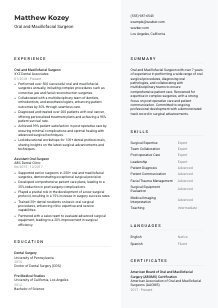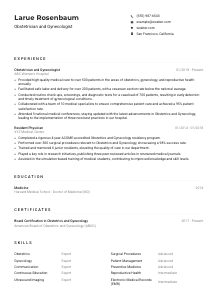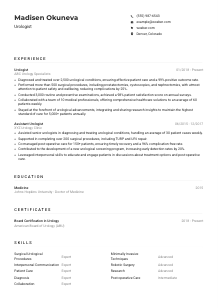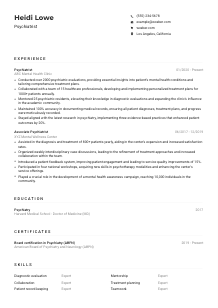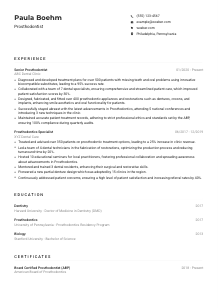Oral and Maxillofacial Surgeon Resume Example
Carving paths to dental advancement, but your resume feels hidden in wisdom teeth? Unearth this Oral and Maxillofacial Surgeon resume example, shaped with Wozber free resume builder. Understand how to extract your surgical skills and expertise, grafting them onto a career roadmap that aligns with job requirements!
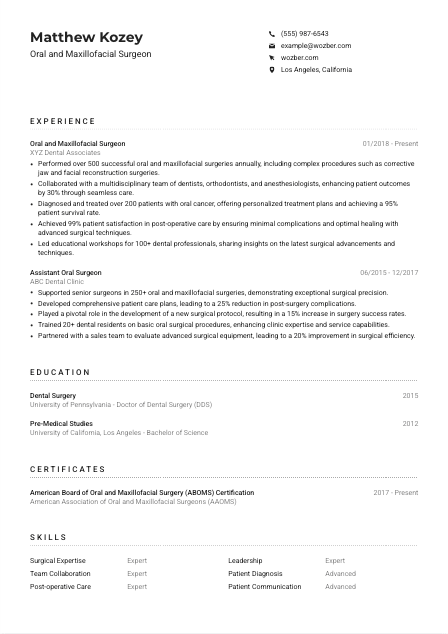
How to write an Oral and Maxillofacial Surgeon resume?
Hello, aspiring Oral and Maxillofacial Surgeon! Crafting a resume that cuts through the competition is crucial in the specialized medical field. With the right guidance, your resume can beautifully illustrate your expertise and dedication to the profession.
Leveraging Wozber's free resume builder, this guide is crafted to navigate you through tailoring your resume to the particular demands of your dream role. Embrace this journey to transform your resume into a powerful narrative that secures you the position of an Oral and Maxillofacial Surgeon!
Personal Details
The pathway to a successful Oral and Maxillofacial Surgeon role starts with your personal details. Making a stellar first impression is key, and it all begins here. Let's dive into how to finesse this section specifically for an Oral and Maxillofacial Surgeon, ensuring it shines brightly in the eyes of your future employer.
1. Your Name as Your Brand
Your name is the cornerstone of your personal brand. Use a clear, professional font and size it a notch above the rest of your resume. This isn't just typography; it's the first step in asserting your presence.
2. Precision in Job Title
Seizing attention from the get-go is crucial. Including ‘Oral and Maxillofacial Surgeon' right beneath your name aligns you immediately with the job at hand. It's a direct signal to hiring managers that you're the exact fit they're searching for.
3. Contact Information Essentials
List your phone and a professional email—think firstname.lastname@example.com. These details must be accurate; a simple typo can mean a missed opportunity. Double-checking is your best friend here.
4. Location Alignment
"Must be located in Los Angeles, California" - as stated in our job description. Highlighting your residence in Los Angeles ensures a smooth beginning by meeting one of the fundamental prerequisites.
5. Web Presence
Adding a professional profile link, like LinkedIn, showcases your network and endorsements. Ensure it's current and reflective of your resume, echoing your attentiveness to detail.
Takeaway
Your personal details are the foundation, framing the initial perception of you. Polished, precise and professional is the trio to remember. Think of this section as your opportunity to initiate a profound professional connection. Make every detail count.





Experience
In oral and maxillofacial surgery, your experience illuminates your capability and commitment to this intricate field. Displaying your experience purposively is critical. Let's unravel how to align your experience with the job requirements, turning it into a compelling testament of your professional journey.
- Performed over 500 successful oral and maxillofacial surgeries annually, including complex procedures such as corrective jaw and facial reconstruction surgeries.
- Collaborated with a multidisciplinary team of dentists, orthodontists, and anesthesiologists, enhancing patient outcomes by 30% through seamless care.
- Diagnosed and treated over 200 patients with oral cancer, offering personalized treatment plans and achieving a 95% patient survival rate.
- Achieved 99% patient satisfaction in post‑operative care by ensuring minimal complications and optimal healing with advanced surgical techniques.
- Led educational workshops for 100+ dental professionals, sharing insights on the latest surgical advancements and techniques.
- Supported senior surgeons in 250+ oral and maxillofacial surgeries, demonstrating exceptional surgical precision.
- Developed comprehensive patient care plans, leading to a 25% reduction in post‑surgery complications.
- Played a pivotal role in the development of a new surgical protocol, resulting in a 15% increase in surgery success rates.
- Trained 20+ dental residents on basic oral surgical procedures, enhancing clinic expertise and service capabilities.
- Partnered with a sales team to evaluate advanced surgical equipment, leading to a 20% improvement in surgical efficiency.
1. Dissecting the Job Requires
Start with understanding each requirement from the job description. For instance, "A minimum of 3 years of post-residency experience in oral and maxillofacial surgery." This guides you on what to highlight.
2. Organizing by Relevance
Structure your experience chronologically, with your most recent accomplishments front and center. Use clear headers for each position: job title, employer, and dates of employment.
3. Showcasing Achievements
"Performed over 500 successful oral and maxillofacial surgeries annually." Quantify your impact wherever possible, translating your expertise and dedication into tangible successes.
4. Relevance Is Key
Filter through your experiences to emphasize the ones that mirror the job requirements closely. Each bullet point under your roles should resonate with the responsibilities and expertise the job seeks.
5. Making Numbers Speak
Incorporate statistics to breathe life into your achievements. Figures like "enhancing patient outcomes by 30%" illustrate your effectiveness in a language that resonates universally.
Takeaway
Think of your experience section as the heartbeat of your resume - it's where your professional narrative comes to life. It's not just about what you did, but how well you did it and the specific impact you had. Capture the essence of your professional journey, align it with the job's needs, and let your experience shine brightly.
Education
The education section is more than a list of degrees; it's an expression of your foundational knowledge and lifelong commitment to learning. It's particularly pivotal for an Oral and Maxillofacial Surgeon. Let's scaffold this section to reflect your educational milestones in alignment with the specific requirements of the role.
1. The Pillars of Education
Zero in on the key educational benchmarks. For this role, a "Medical degree (MD or DDS), completion of an accredited Oral and Maxillofacial Surgery residency program" is crucial. Make sure these are prominently listed.
2. Structure for Clarity
Maintain clarity with a streamlined listing of your education. Each entry should succinctly include the degree, field of study, and the institution, alongside the graduation date.
3. Mirroring Job Requirements
Tailoring your educational details to the role's requirements forms a direct bridge to your eligibility. The degrees you list must directly reflect the qualifications sought by the employer.
4. Relevant Coursework
While specific coursework didn't need highlighting in our example, consider mentioning pertinent courses if they add significant value, especially if they align closely with the role's specialized demands.
5. Additional Achievements
If you have educational achievements that showcase your passion and dedication—like honors or relevant extracurriculars—include them. It's about painting a comprehensive picture of your commitment to the field.
Takeaway
Your education tells the story of your commitment to this demanding field. Handle it meticulously to provide a clear, comprehensive view of your background. Let it stand as a testament to your readiness and qualification for the Oral and Maxillofacial Surgeon role. Remember, you're not just listing degrees; you're showcasing your journey of growth and learning.
Certificates
In the realm of oral and maxillofacial surgery, certificates are badges of honor. They signify your continuous growth and recognition by authoritative bodies. Here's how to curate your certificates section to cast a spotlight on your specialized competencies and ongoing professional development.
1. Focus on Relevance
Reflect back on the job's requirements, particularly those like "Board certification or eligibility with the American Board of Oral and Maxillofacial Surgery (ABOMS)." Ensure your most pertinent certifications are not just listed, but highlighted.
2. Selection with Intent
Limit your list to certifications that underscore your expertise and commitment to the field. A concise, impactful list tells a story of dedication and continuous improvement.
3. Date Transparency
Dates matter, especially in fields that evolve as rapidly as medicine. Indicating the validity of your certification demonstrates your diligence in staying current.
4. Pursuit of Excellence
The medical field never stands still, and neither should you. Highlight your intention and actions towards gaining additional certifications, underscoring your drive for excellence and leadership in the field.
Takeaway
Your certificates are more than accolades; they are tangible proof of your relentless pursuit of excellence. Choose wisely and present them with pride, ensuring they align with the role's requisites and your career path. Let them echo your unwavering commitment to advancing in the field of Oral and Maxillofacial Surgery.
Skills
The skills section of your resume is where you concisely convey your professional toolkit. For an Oral and Maxillofacial Surgeon, this is pivotal. Let's dive into architecting a skills section that effectively resonates with the job at hand, showcasing your readiness to excel.
1. Extracting the Essence
Review the job description and identify both explicit and implied skills. Skills like "Ability to effectively communicate with patients and collaborate with multidisciplinary teams" are central to the role.
2. Tailoring Your Toolkit
Focus on listing skills that directly match the job description. This is where Wozber's ATS resume scanner becomes invaluable, helping you ensure your skills are not just relevant, but also optimized for ATS systems.
3. Structured and Selective
Resist the urge to overstuff this section. A meticulously chosen list of skills, both hard and soft, crafted in alignment with the job's requirements, packs a more potent punch.
Takeaway
Crafting a skills section with intention and precision signals to hiring managers that you not only understand the role's demands but are also the perfect fit for it. It's an opportunity to shine and to communicate the unique value you bring to the table. Approach it as your moment to highlight the skills that make you the ideal Oral and Maxillofacial Surgeon.
Languages
In a field as diverse and global as oral and maxillofacial surgery, your linguistic abilities can set you apart. Whether you're dealing with international research or a multicultural patient base, languages are invaluable. Here's how to weave your linguistic skills into your resume.
1. Comprehending Requirements
First off, assess if the job specifies any language requirements. In our example, "English speaking skills are mandatory." This becomes your primary language to highlight.
2. Prioritizing Key Languages
Lead with the languages essential for the role. Your proficiency level in these languages speaks volumes about your ability to communicate effectively in professional settings.
3. Broadening your Linguistic Palette
Beyond the necessities, list other languages you're fluent in. Even if not directly required, additional languages showcase your adaptability and global perspective.
4. Honesty in Proficiency
Accuracy in portraying your language skills is essential. Misrepresenting your proficiency can lead to misunderstandings or challenges down the line.
5. Understanding the Role's Demands
When the job involves interacting with a diverse patient demographic or requires collaboration across borders, emphasizing your multilingual capabilities can significantly boost your appeal as a candidate.
Takeaway
Your ability to communicate in multiple languages is a testament to your adaptability and readiness to engage in a globally connected world. Flaunt this skill, understanding that each language you speak is a bridge to better understanding, empathy, and care in your profession as an Oral and Maxillofacial Surgeon.
Summary
Your summary is the narrative bow tying your professional package together. It's your chance to make a compelling case for why you're not just a great candidate, but the right one for the Oral and Maxillofacial Surgeon role. Let's unveil how to make your summary resonate with your professional ethos and the job's demands.
1. Distilling the Job's Essence
Start by absorbing the deepest needs and goals of the role. Reflect on how your career experiences and achievements align with these demands.
2. Opening Strong
Kick-off with an assertive statement that encapsulates your profession and level of experience: "Oral and Maxillofacial Surgeon with over 7 years of experience..." It sets the tone.
3. Addressing Needs and Achievements
Highlight your key skills and accomplishments next. Your objective is to weave in how your specific experiences and successes address the job's needs.
4. Brevity with Impact
This section should be succinct yet impactful. Think of it as your professional headline, capturing the essence of your career trajectory and its alignment with the role you're pursuing.
Takeaway
Your summary shouldn't just echo the rest of your resume—it should emphasize your unique selling points and how they align with what the job entails. Tailoring it meticulously to the role proves you're not only a qualified candidate but a dedicated professional eager to make a real impact as an Oral and Maxillofacial Surgeon.
Embarking on Your Oral and Maxillofacial Surgeon Journey
Congratulations! You've sculpted a resume that truly speaks volumes. Remember, your resume is a living document—continue refining it as you grow in your career. Use it as a tool to pave your way into your desired Oral and Maxillofacial Surgeon role.
Wozber's free resume builder is here to assist, offering ATS-friendly resume templates and an ATS resume scanner to ensure your application is optimized and ready to shine. Let your resume be the key that opens doors to new opportunities and chapters in your professional saga.

- Medical degree (MD or DDS), completion of an accredited Oral and Maxillofacial Surgery residency program.
- Board certification or eligibility with the American Board of Oral and Maxillofacial Surgery (ABOMS).
- Active state medical license with the ability to obtain or currently hold state-specific sedation permits or certifications.
- A minimum of 3 years of post-residency experience in oral and maxillofacial surgery, with expertise in areas such as corrective jaw surgery, facial trauma, and facial reconstruction.
- Ability to effectively communicate with patients and collaborate with multidisciplinary teams, demonstrating strong interpersonal and empathetic skills.
- English speaking skills are mandatory.
- Must be located in Los Angeles, California.
- Perform complex surgeries involving the mouth, jaw, and facial structures such as dental extractions, wisdom tooth removals, and orthodontic-related procedures.
- Diagnose and offer treatment plans for patients with oral and maxillofacial irregularities or pathologies, including oral cancer.
- Collaborate with dentists, orthodontists, and other medical professionals to provide comprehensive patient care.
- Manage post-operative care, ensuring patients have minimal complications and optimal healing.
- Participate in continuing education and professional development to stay current with the latest surgical techniques and advancements.





